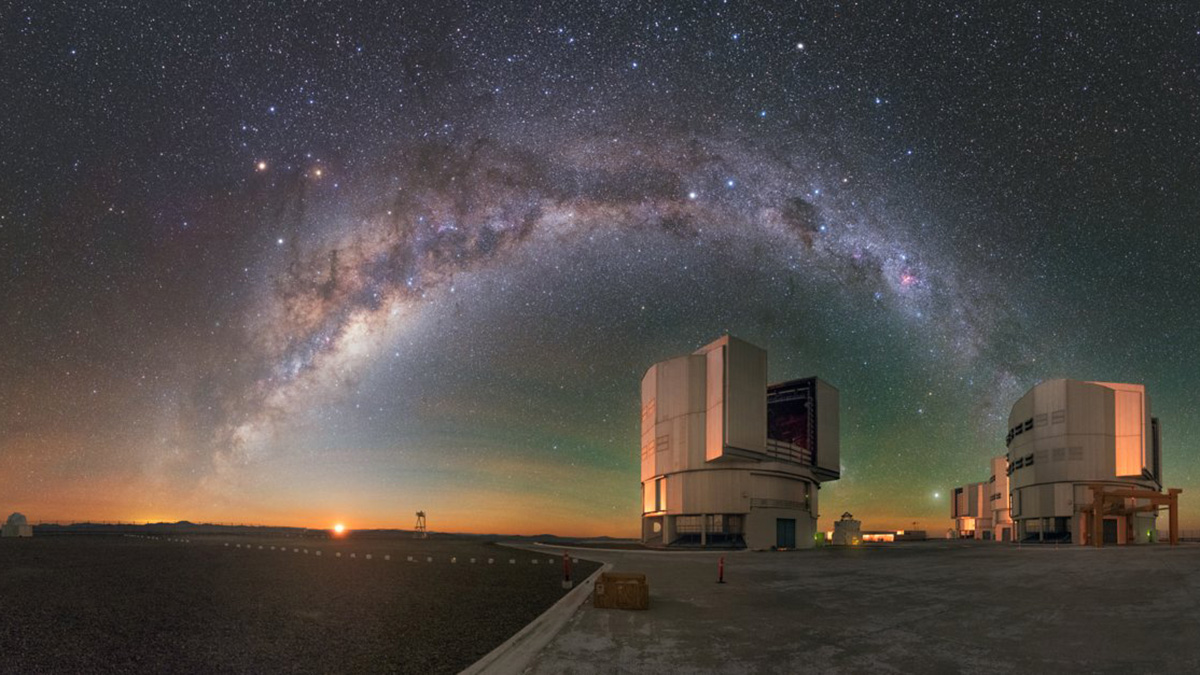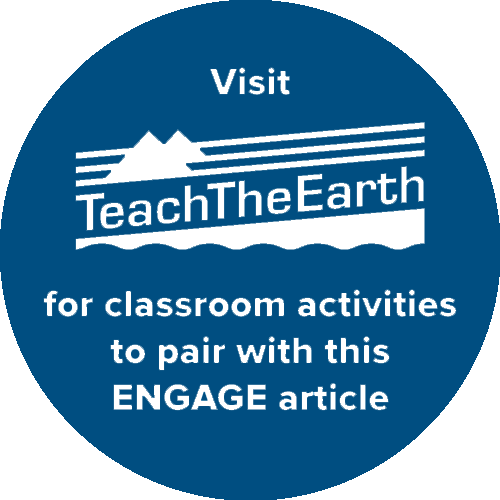A new 600-page report released yesterday outlines what the field of astronomy hopes to accomplish in the next 10 years. Pathways to Discovery in Astronomy and Astrophysics for the 2020s, or Astro2020 for short, is the seventh and latest astronomy decadal survey. It seeks to assess the current state of the field and provide a road map for astronomy research and technological development in the United States for 2023–2032.
More than 1,400 astronomers submitted more than 850 white papers expressing their scientific dreams for the near future.
As the name suggests, a new astronomy decadal survey is compiled and released about once a decade, although Astro2020’s release was delayed because of a monthlong government shutdown in late 2018 and then by the COVID-19 pandemic. More than 1,400 astronomers submitted more than 850 white papers expressing their scientific dreams for the near future, and 141 people across 13 panels distilled those ideas down to a set of recommendations from the astronomy community to funding and policy agencies. The decadal surveys are funded and released by the National Academies of Sciences, Engineering, and Medicine.
Past astronomy decadal surveys led to the development of flagship telescopes like the Hubble Space Telescope and its contemporaries, the Nancy Grace Roman Space Telescope, and the James Webb Space Telescope (JWST). In a sharp deviation from the past, no single flagship telescope mission takes center stage in the new report—and thus, none takes highest priority for funding and development. Rather, the report recommends a number of small- and midsize mission programs, large ground-based observatories, a focus on issues across the workforce and society, and a more strategic approach to large missions like JWST.
“If we can really achieve this new paradigm for developing large strategic missions at NASA. . .we can plan and develop them more coherently, increase the launch rate, and provide very important capabilities over a wide range of wavelengths,” Fiona Harrison, an astrophysicist at the California Institute of Technology in Pasadena and cochair of the steering committee for this decadal survey, said during a public briefing on 4 November.
Astro2020 outlines three major science themes for the next decade: the interconnected evolution of planets and stars from birth to death, understanding the most energetic and hard-to-measure physical processes like dark energy and gravitational waves, and mapping the formation and evolution of the universe. These priority science goals inform and justify the report’s program and telescope goals, all of which are supported by and enabled by goals for the workforce and state of the profession.
Some of the report’s goals are specific to the field and profession of astrophysics, but many of the recommendations offer opportunities for the geoscience community to collaborate. Here are five takeaways.
1. Astronomy Focuses on the Sky, but Its Impacts Are Earthbound
Most academic disciplines, astronomy and geoscience included, have long relied on in-person science activities like fieldwork, telescope observations, and conferences. The ongoing pandemic has forced an increase in remote participation in science that has created a model for going forward in a more environmentally conscious way. “The astronomy community should increase the use of remote observing, hybrid conferences, and remote conferences, to decrease travel impact on carbon emissions and climate change,” the report recommends.
2. Tomorrow’s Science Needs to Be More Equitable Than It Is Today
“Everyone deserves the right to work in a professional environment.”
STEM (science, technology, engineering, and mathematics) fields share the problem of having a workforce that is not representative of the world’s population, as well as being built on structures that systemically exclude, discriminate against, and diminish the contributions of non-white and non-cis male scientists. “Everyone deserves the right to work in a professional environment,” Rachel Osten, an astronomer at the Space Telescope Science Institute and Johns Hopkins University and executive officer for this decadal survey, said during the briefing. “We think that it’s necessary to take a stand about what we as a field believe in as far as how people should be treated.”
Astro2020 includes a suite of recommendations to combat this problem, including, but not limited to, considering the demographics of funding proposal authors; defining a community astronomy model of engagement that advances scientific research while respecting, empowering, and benefiting local communities; ensuring that scientific integrity policies consider harassment and discrimination as scientific misconduct; removing the Graduate Record Exam (GRE) from admissions requirements; and providing more funding and bridge programs for early-career scientists.
3. Lab Experiments and Data Archives Cross Disciplines
Planetary materials science and other experimental laboratory work have been key for understanding the most surprising and strange discoveries about planets in our solar system, the evolution of the Earth-Moon system, exoplanets that don’t have a solar system analogue, and places that might host life. Astro2020 recognized the valuable role that lab work plays in putting astrophysical observations in context and recommended identifying the research areas that need more laboratory data, what resources are needed to accomplish those lab experiments, and how to make those data easier to access and use.
4. Finding Signs of Life on Distant Worlds Is Within Our Grasp
The past decade has seen a rapid growth in the number of known extrasolar planets as well as in what we know about those planets’ sizes, temperatures, and atmospheres. The upcoming JWST will continue to expand what we know about which worlds might be hospitable for life—but it likely won’t be the one to find life, and neither will NASA’s next flagship telescope, Roman. Neither of those flagships has launched yet, and the Astro2020 steering committee chose to not recommend any specific telescope as the next flagship to develop. Instead, they recommended a not-yet-designed 6-meter space telescope with observing capabilities in infrared, visible, and ultraviolet light that can detect biosignatures in exoplanet atmospheres.
The specifications point to a hybrid between two well-developed telescope ideas, LUVOIR (Large UV/Optical/IR Surveyor) and HabEx (Habitable Exoplanet Observatory). The informally dubbed “LuvEx” would be the first large (more than $1.5 billion) mission to come from the recommended Great Observatories Mission and Technology Maturation Program, a more strategic approach to large mission planning.
5. Large Ground-Based Telescopes Build a Complete Picture of Planet Formation
“They will be workhorses, eventually for follow-up to James Webb observations.”
What hides beneath an exoplanet’s atmosphere? How does a cloud of gas and dust become a potentially habitable planet? Ground-based observatories help answer these questions by gathering light from young and still-forming planets at high resolution. In-development observatories like the European Extremely Large Telescope and the Square Kilometer Array will advance these studies, and Astro2020 recommends two or three U.S.-led programs to complement those: a next-generation long baseline array for radio interferometry and a 30-meter-scale optical telescope (either the Giant Magellan Telescope, the Thirty Meter Telescope, or both, with a final decision made by 2023).
“These instruments provide up to six times the spatial resolution of Hubble” and better optics and light sensitivity, Robert Kennicutt, a professor at the University of Arizona and Texas A&M University and cochair of the steering committee for the survey, explained at the briefing. “It just opens up the range of targets. They will be workhorses, eventually for follow-up to James Webb observations.”
From Recommendations to Action
Although decadal surveys carry no power to implement the recommendations they propose, funding agencies and policymakers alike will look to Astro2020 to help decide which programs, large and small, to fund and develop in the coming years. “If a project wasn’t highly ranked, we knew it didn’t have the community’s endorsement,” Joel Parriott, director of public policy at the American Astronomical Society and formerly of the White House Office of Management and Budget, told Scientific American. “That’s really helpful for folks on Capitol Hill and in the White House who need to make hard choices.”
—Kimberly M. S. Cartier (@AstroKimCartier), Staff Writer
This news article is included in our ENGAGE resource for educators seeking science news for their classroom lessons. Browse all ENGAGE articles, and share with your fellow educators how you integrated the article into an activity in the comments section below.


